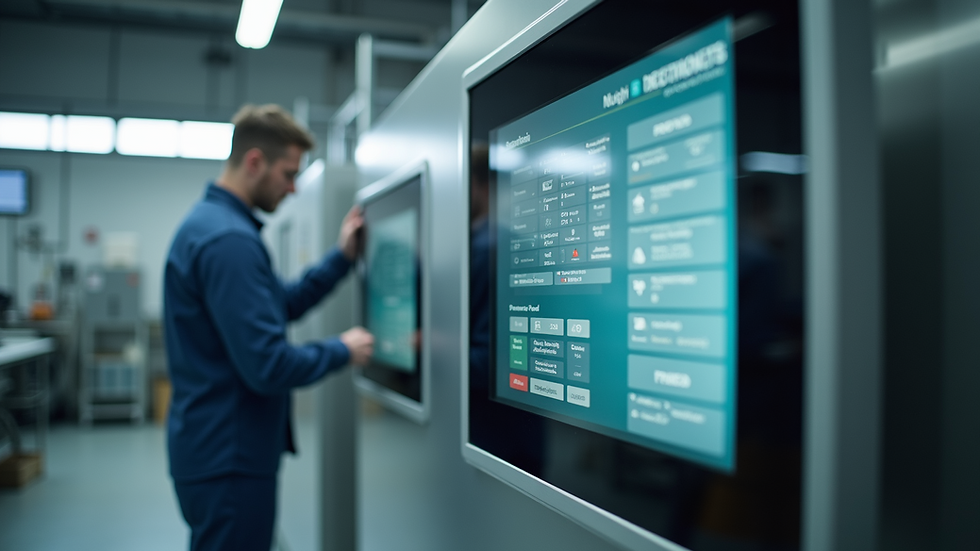Enhance Automation Control with Comfort Panel Solutions
- Ryan Patrick Murray
- Sep 22
- 3 min read
In today's fast-paced industrial environment, automation control panels play a crucial role in streamlining operations and improving efficiency. One of the most effective ways to enhance these systems is by integrating advanced Human Machine Interface (HMI) solutions like the Siemens Comfort Panel. This blog post explores how Comfort Panel solutions can elevate your automation control panels, offering practical insights and actionable recommendations to optimize your control systems.
Understanding Automation Control Panels and Their Importance
Automation control panels are the backbone of modern industrial processes. They house the electrical components that control machinery and processes, ensuring smooth and safe operation. These panels typically include controllers, relays, circuit breakers, and HMIs, which allow operators to interact with the system.
Key Functions of Automation Control Panels:
Centralized control of machinery and processes
Monitoring system status and performance
Ensuring safety through protective devices
Facilitating troubleshooting and maintenance
By integrating advanced HMIs like the Siemens Comfort Panel, these control panels become more user-friendly and efficient, enabling operators to make informed decisions quickly.

How Automation Control Panels Benefit from Advanced HMI Solutions
Automation control panels are significantly enhanced by incorporating sophisticated HMI devices. The Siemens Comfort Panel is a prime example, offering a range of features that improve usability and system performance.
Advantages of Using Comfort Panel in Automation Control Panels:
Intuitive Touchscreen Interface: Simplifies operator interaction with clear visuals and easy navigation.
High-Resolution Displays: Provide detailed process data and graphics for better monitoring.
Robust Design: Suitable for harsh industrial environments, ensuring durability.
Flexible Connectivity: Supports various communication protocols for seamless integration.
Customizable Screens: Tailored to specific process requirements, improving operational efficiency.
These features help reduce operator errors, speed up response times, and enhance overall system reliability.

What is the price of Siemens HMI 15 inch?
When considering the integration of a Siemens HMI 15 inch Comfort Panel into your automation control panels, understanding the cost is essential for budgeting and planning.
Pricing Factors:
Model and Specifications: Different models offer varying features, affecting the price.
Display Size and Resolution: Larger and higher-resolution screens typically cost more.
Additional Modules: Optional communication or expansion modules can increase the price.
Supplier and Region: Prices may vary depending on the distributor and location.
On average, the Siemens HMI 15 inch ComfortPanel ranges from $1,200 to $2,500 depending on the configuration and supplier. For precise pricing and availability, it is recommended to consult authorized distributors or visit specialized suppliers like comfortpanel.
Tips for Cost-Effective Purchasing:
Assess Your Needs: Choose a model that fits your specific application to avoid overpaying.
Compare Suppliers: Look for competitive pricing and reliable after-sales support.
Consider Long-Term Value: Invest in quality to reduce maintenance and replacement costs.
Practical Tips for Integrating Comfort Panel into Your Automation System
Integrating a Comfort Panel into your existing automation control panels requires careful planning and execution. Here are some practical recommendations to ensure a smooth integration:
Step-by-Step Integration Guide:
Evaluate Compatibility: Check if the Comfort Panel supports your control system’s communication protocols.
Plan the Layout: Design the panel layout to accommodate the new HMI without overcrowding.
Configure Software: Use Siemens’ programming tools to customize the interface according to your process needs.
Test Thoroughly: Perform comprehensive testing to verify functionality and responsiveness.
Train Operators: Provide training to ensure users can effectively operate the new system.
Additional Considerations:
Environmental Protection: Ensure the panel enclosure meets the required IP rating for your environment.
Power Supply: Verify that the power requirements of the Comfort Panel are compatible with your system.
Backup and Recovery: Implement data backup procedures to prevent loss of critical information.
By following these steps, you can maximize the benefits of the Comfort Panel and enhance your automation control panels’ performance.
Future Trends in Automation Control Panels and HMI Technology
The field of automation control panels is continuously evolving, driven by advancements in HMI technology and digitalization. Understanding these trends can help you stay ahead and make informed decisions about upgrading your systems.
Emerging Trends:
Increased Connectivity: Integration with IoT devices and cloud platforms for real-time data analytics.
Enhanced User Experience: Use of augmented reality (AR) and voice control to simplify operations.
Cybersecurity Focus: Implementation of robust security measures to protect control systems from cyber threats.
Energy Efficiency: Development of energy-saving components and smart monitoring tools.
Modular Designs: Flexible and scalable panels that can be easily upgraded or expanded.
Adopting these innovations will ensure your automation control panels remain efficient, secure, and future-proof.
By leveraging advanced solutions like the Siemens Comfort Panel, you can significantly improve the functionality and usability of your automation control panels. Whether you are upgrading an existing system or designing a new one, these insights and recommendations will help you achieve better control, increased productivity, and enhanced safety in your industrial operations.


